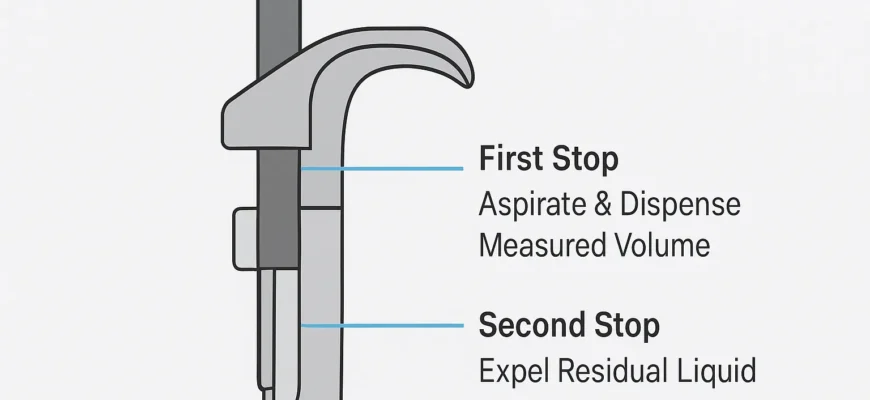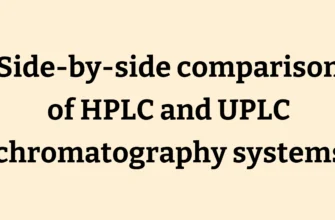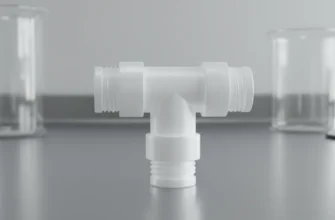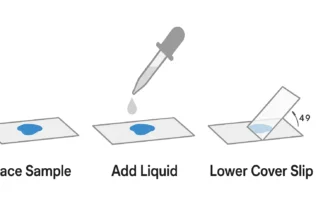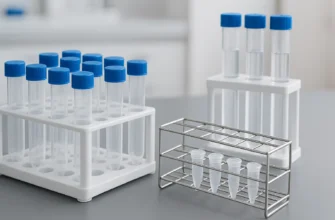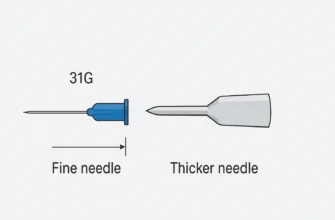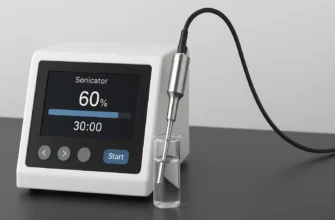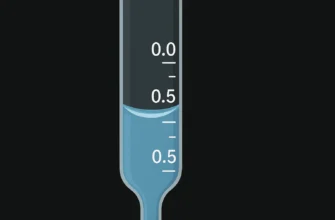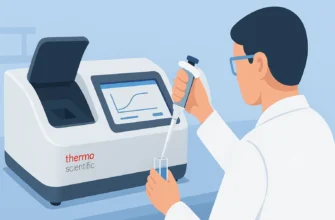Mastering the Pipette Plunger: First Stop vs. Second Stop
Understanding the difference between your pipette’s first stop and second stop is fundamental to accurate liquid handling in any laboratory. This comprehensive guide reveals how these two critical positions on your pipette plunger control precision, prevent common errors, and ensure reliable experimental results.
The Heart of the Matter: Two Stops, One Purpose
Every air displacement pipette features two distinct plunger positions that work together to achieve precise liquid transfer. The first stop controls volume measurement, while the second stop ensures complete liquid delivery. This dual-stop mechanism forms the foundation of laboratory accuracy, yet many technicians struggle to use these stops correctly, leading to systematic errors that compound throughout experiments.
The plunger force required differs significantly between stops. The first stop typically requires 3-15 Newtons of force – the “soft stop” that you should feel as a gentle resistance. The second stop can require up to 40 Newtons – the “hard stop” at the plunger’s endpoint that demands deliberate additional pressure.
Feeling the Clicks: A Tour of Your Pipette’s Plunger
Defining the First Stop (The Point of Measurement)
The first stop represents the calibrated volume position on your pipette. When you depress the plunger to this point, you’re setting the exact air displacement volume that will draw liquid into the tip. This stop should be easily felt as consistent resistance, allowing you to achieve repeatable technique with practice.
Think of the first stop as your pipette’s “measurement mark” – it defines the precise volume you intend to transfer. During aspiration, releasing the plunger from the first stop creates the negative pressure that draws liquid into the tip.
Defining the Second Stop (The Point of Complete Expulsion)
The second stop lies beyond the first stop and requires additional force to reach. This position serves to expel any remaining liquid that might cling to the tip’s interior due to surface tension. The second stop pushes out approximately 10% more air than the calibrated volume, ensuring complete sample delivery.
When you press beyond the first stop to the second, you’re performing what’s called a “blowout” – forcing out the last droplet that would otherwise remain in the tip.
The Simple Analogy: “Sipping” vs. “Blowing Out”
The first stop is like taking a measured sip through a straw – you control exactly how much enters. The second stop is like blowing out that last bit stuck at the bottom – ensuring nothing gets left behind. This simple mental model helps maintain proper technique throughout your pipetting workflow.
The Dynamic Duo: Forward and Reverse Pipetting
Forward Pipetting (The Standard Method)
Forward pipetting represents the most commonly used technique in laboratory settings, offering intuitive operation and excellent accuracy for routine aqueous solutions.
Process: Depress the plunger to the first stop, immerse the tip 2-3mm below the liquid surface, slowly release to aspirate, then dispense by pressing to the first stop followed by the second stop to expel remaining liquid.
Ideal for: Aqueous solutions, buffers, diluted acids and bases, salt solutions, and any standard laboratory liquids with low viscosity and minimal volatility.
Forward pipetting provides superior accuracy when performed correctly, particularly for small volumes where precision matters most. However, this technique can introduce bubbles when dispensing to the second stop, especially with detergent-containing or protein solutions.
Reverse Pipetting (For Tricky Liquids)
Reverse pipetting compensates for liquid retention characteristics by aspirating excess volume initially, ensuring accurate delivery regardless of the liquid’s physical properties.
Process: Depress the plunger all the way to the second stop before immersion, slowly release to aspirate more than the target volume, dispense by pressing only to the first stop (leaving excess in the tip), then discard the remaining liquid.
Ideal for: Viscous liquids (glycerol, concentrated proteins), volatile solvents (ethanol, acetone, chloroform), foaming liquids (detergent solutions, serum), and oils.
The effectiveness of reverse pipetting lies in its compensation mechanism. When viscous liquids exhibit high surface tension and adhere to tip walls, the retained film comes from the initial excess rather than the measured dose, ensuring the full target volume is dispensed.
Quick-Reference Comparison Table
| Feature | Forward Pipetting | Reverse Pipetting |
|---|---|---|
| Aspiration stop | First stop | Second stop |
| Dispense stop | Second stop (blowout) | First stop only |
| Best for | Aqueous solutions, buffers | Viscous, volatile, foaming liquids |
| Accuracy | Highest for water-like liquids | Highest for challenging liquids |
| Bubble formation | Common with second stop | Minimal (no blowout) |
| Liquid waste | Minimal | ~10% remains in tip |
| Technique complexity | Simpler | Requires practice |
Why It Goes Wrong: Common Mistakes and Their Impact
Aspirating to the Second Stop (Forward Mode Error)
When you accidentally depress the plunger to the second stop before aspiration in forward mode, you draw in 10% more volume than intended. This seemingly small error can cause 8-12% inaccuracy in transferred volumes. The problem multiplies in serial dilutions, where this mistake in the first step cascades through subsequent dilutions, rendering your final concentrations completely unreliable.
Dispensing Only to the First Stop (Incomplete Delivery)
Stopping at the first stop during forward pipetting leaves a small volume – typically 0.5-2μL depending on tip size – clinging to the tip’s interior wall. This residual liquid represents precious sample that never reaches your destination vessel. For a 20μL transfer, leaving 1μL behind means 5% under-delivery, systematically skewing all downstream results.
Applying Inconsistent Technique
Variations in plunger speed, immersion angle, and pause times between technicians – or even by the same person throughout the day – introduce random errors that destroy reproducibility. Studies show that inconsistent pipetting angle alone can alter delivered volume by 0.29-0.53% depending on the deviation from vertical. When combined with other technique variations, total error easily exceeds 10%.
The Real-World Consequence: How These Errors Skew Your Experimental Data
These pipetting mistakes don’t just affect individual measurements – they systematically bias your entire dataset. In PCR reactions, volume errors alter primer and template concentrations, causing amplification failures or non-specific products. In ELISA assays, improper pipetting creates diffuse clusters and trailing patterns that make interpretation impossible. For calibration curves, accumulated errors in serial dilutions produce non-linear relationships that invalidate quantification.
A laboratory study measuring pipetting accuracy without proper technique found error rates reaching 8-12% for small volumes, compared to under 2% when good practices were followed. This difference can mean the distinction between publishable results and months of troubleshooting.
Beyond the Stops: Habits for Flawless Pipetting
Pre-Rinsing Your Tips for Consistency
Pre-wetting (also called pre-rinsing) involves aspirating and dispensing your sample liquid 3-5 times before the final transfer. This critical step equilibrates the humidity inside the tip and saturates the air column, preventing the first dispense from delivering less volume due to evaporation effects.
Without pre-wetting, the initial dispenses show systematic under-delivery. Studies demonstrate that skipping this step causes 0.5-1μL volume loss on first use with aqueous solutions, and even more with volatile liquids. For volatile solvents like ethanol, increase pre-wetting cycles to at least five times to fully saturate the air column and prevent dripping.
The Importance of a Smooth Rhythm and Proper Pause
Consistent plunger speed and timing create repeatable results. After aspirating, pause for one second with the tip still immersed before withdrawing from the liquid. This pause allows liquid flow to stabilize and prevents under-aspiration. Similarly, after dispensing to the first stop, pause briefly before pressing to the second stop, then drag the tip up the vessel wall while completing the blowout.
Rushing these steps or varying your rhythm between replicates introduces random error that destroys precision. Electronic pipettes eliminate this variability by maintaining consistent piston movement speed, reducing user-dependent variation.
How Immersion Depth and Angle Affect Your Result
Hold your pipette within 20 degrees of vertical during both aspiration and dispensing. Deviating beyond this angle increases delivered volume through altered hydrostatic pressure – a 100μL pipette held at 60° delivers an extra 0.53μL (0.53% error), while a 1000μL pipette at 45° adds 2.9μL (0.29%).
Immersion depth matters equally. For volumes up to 100μL, immerse the tip only 2-3mm below the meniscus; for 100-1000μL, 2-4mm; for larger volumes, 3-6mm. Immersing too deeply causes excess liquid to cling to the tip’s exterior, while insufficient immersion risks aspirating air. Both scenarios compromise accuracy by up to 5%.
Always Change the Tip: The Non-Negotiable Rule for Serial Work
Using a fresh tip for every new sample or reagent is fundamental to preventing cross-contamination. Even trace amounts carried over on a used tip can ruin sensitive assays, introduce substrate interference, or invalidate quantitative measurements.
During serial dilutions, the temptation to reuse tips to save time and materials is strong, yet this practice guarantees error accumulation. Each dilution step requires a clean tip to maintain the integrity of your concentration series.
Troubleshooting in the Trenches: Answering Your Questions
“Why Do I Always Get Bubbles?” (Hint: It’s Often a Technique or Liquid Choice Issue)
Bubbles form when you push to the second stop while the tip is submerged in liquid, forcing air through the remaining sample. This is expected behavior with forward pipetting and doesn’t necessarily indicate error – unless bubbles interfere with your assay (such as spectrophotometric readings or loading samples into gels).
To minimize bubbles, dispense with the tip against the vessel wall at a 45-degree angle, press to the first stop, pause, then press to the second stop while simultaneously dragging the tip up the wall. Alternatively, switch to reverse pipetting for foam-prone liquids – since you stop at the first stop, no air blowout occurs, eliminating bubble formation entirely.
For detergent-containing solutions or protein samples, reverse pipetting is your best defense against unwanted foam. Additionally, slow down your dispensing speed and ensure your technique is smooth rather than forceful.
“When Do I Always Use the Second Stop?” (Clarifying Aspiration vs. Dispensing)
During aspiration: Always stop at the first stop in forward mode. Only press to the second stop before aspiration when performing reverse pipetting.
During dispensing: In forward mode, dispense to the first stop, pause, then press to the second stop for complete delivery. In reverse mode, dispense only to the first stop and discard the excess remaining in the tip.
The confusion often arises because the second stop serves opposite functions depending on when you use it. Before aspiration (reverse mode), it draws in excess volume. After dispensing to the first stop (forward mode), it expels residual liquid.
“My Results Are Inconsistent – What Now?” (A Quick Checklist for Diagnostics)
When facing irreproducible results, systematically check these factors:
Calibration status: Test your pipette’s accuracy using a calibrated balance and distilled water (1000μL should weigh 0.9977g at 20°C). If values fall outside acceptable tolerance, schedule professional calibration.
Tip fit: Ensure tips are compatible with your pipette brand and form an airtight seal. Poorly fitting tips cause leakage errors up to 50%.
Technique consistency: Film yourself pipetting and watch for variations in angle, plunger speed, immersion depth, and pause timing.
Temperature equilibration: Allow pipettes, tips, and liquids to reach the same temperature (minimum 30 minutes, ideally 2 hours). Temperature mismatches affect the air cushion volume, causing systematic errors.
Environmental factors: Check for drafts, high humidity, or temperature fluctuations in your work area that could affect evaporation or air displacement.
Liquid properties: Consider whether your sample is viscous, volatile, or prone to foaming – if so, switch from forward to reverse pipetting.
Maintenance needs: Inspect seals, O-rings, and internal components for wear or contamination requiring cleaning or replacement.
The Final Dispense: Key Takeaways
Mastering your pipette’s first and second stops is fundamental to reliable laboratory work. The first stop controls measured volume – use it for aspiration in forward mode and dispensing in reverse mode. The second stop ensures complete delivery – press to it after dispensing in forward mode, or before aspiration in reverse mode.
Choose forward pipetting for aqueous solutions and standard buffers, achieving optimal accuracy through the first-stop aspiration, second-stop dispensing sequence. Switch to reverse pipetting for viscous, volatile, or foaming liquids, aspirating to the second stop and dispensing only to the first stop to compensate for retention effects.
Consistent technique matters as much as understanding the mechanics. Pre-wet tips 3-5 times, maintain vertical pipette angle within 20 degrees, immerse to the proper depth (2-3mm for small volumes), pause one second after aspiration, and always use fresh tips between samples. These habits transform theoretical knowledge into practical precision.
When troubleshooting inconsistent results, systematically evaluate calibration status, tip fit, technique variations, temperature equilibration, and whether your liquid properties require reverse pipetting. Small adjustments to these factors can dramatically improve accuracy and reproducibility.
Remember: every experiment’s reliability ultimately depends on the liquid handling that precedes it. By mastering the first and second stops – and the techniques that leverage them – you ensure your pipetting supports rather than undermines your scientific work.

